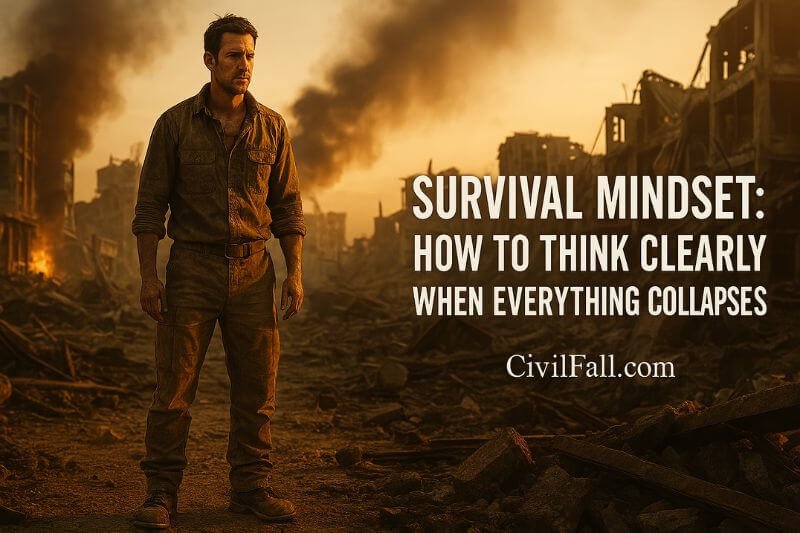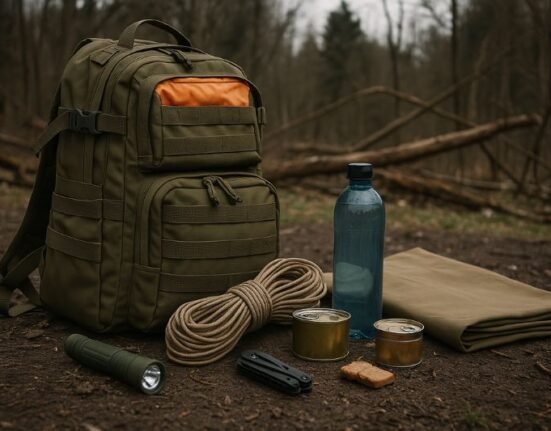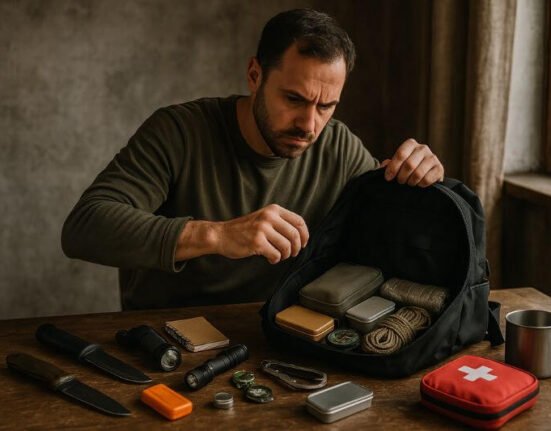In the middle of a total collapse, it’s not muscle or gear that saves you. It’s your survival mindset. The ability to think clearly when the world falls apart is a skill few master — but it’s the most essential one of all.
When Chaos Hits, Mental Clarity Becomes Your Lifeline
Picture this: no electricity, empty shelves, distant sirens, and rising panic. At that moment, your brain becomes your greatest ally — or your worst enemy.
Without a trained mind, your decisions become erratic. Dangerous. Even fatal.
The survival mindset isn’t just about staying calm — it’s about taking smart action under pressure.
It’s a mental toolkit forged through experience, sharpened by strategy, and refined by adversity. Soldiers, firefighters, rescue workers — they all rely on it. And so should you.
Why Most Preppers Neglect the Mind
In prepper circles, there’s endless talk about bug-out bags, water filtration, weapons. But rarely about psychology.
And that’s a deadly mistake.
“90% of survival mistakes come from poor mental responses, not lack of gear.” — FEMA Field Guide, Crisis Response 2020
Mental paralysis, panic, denial — these kill faster than hunger or thirst.
But here’s the good news: with the right mindset training, they can be prevented.
The 3 Core Pillars of the Survival Mindset
1. Mental Clarity Under Pressure
In high-stress situations, most people respond emotionally, not rationally.
Even strong, physically trained individuals can break down if the mind isn’t ready.
Military strategists use the OODA Loop — Observe, Orient, Decide, Act — to stay in control.
Here’s how to apply it in a survival scenario:
- Observe your environment calmly
- Orient without assumptions
- Decide based on logic, not fear
- Act decisively, then repeat
“Clarity is the first casualty of fear.” — U.S. Navy SEAL Survival Doctrine
2. Emotional Control in Crisis
You can’t eliminate fear — but you can train to navigate it.
During disasters, the emotional brain takes over. That “fight-or-flight” mechanism? It works great against wild animals. Less so during civil unrest or nuclear fallout.
Use these techniques:
- Box breathing: 4 seconds inhale → 4 hold → 4 exhale → 4 hold
- Label your emotions: “This is fear. It will pass.”
- Maintain positive self-talk: “I can handle this.”
Big mistake to avoid: believing you’re “immune” to panic.
Nobody is. But with training, you can override it.
3. Rapid Adaptability
Resilience isn’t about staying rigid. It’s about changing strategy when needed.
A rigid mindset breaks. A flexible one survives.
“Adaptability is the top survival trait.” — WHO, Global Humanitarian Report
Example: If your bug-out route is blocked, do you freeze… or pivot?
A true survivalist thinks in branches: Plan A, B, C — and improvises when needed.
Table: Survival Mindset vs Untrained Mind
| Situation | Untrained Response | Survival Mindset Response |
|---|---|---|
| Sudden disaster | Panic, indecision | Observe, decide, act |
| Resource shortage | Despair, breakdown | Prioritize, adapt |
| Injury | Shock, helplessness | Treat, stabilize, improvise |
| Group conflict | Aggression or withdrawal | Lead calmly, de-escalate |
The Real Danger of Group Panic
Ever seen people trample each other for bottled water? That’s herd panic.
In collapse scenarios, emotionally unstable people can become a threat.
Your survival mindset is not just your defense — it’s your tool to lead others out of chaos.
Tips to stabilize group behavior:
- Step into a calm leadership role
- Use short, clear commands
- Separate extreme panic cases without force
Real-World Case: Hurricane Katrina
During Hurricane Katrina, many survivors weren’t harmed by floodwaters — but by mental collapse.
Disorientation. Despair. Decision paralysis.
Those who made it? They had mental anchors — routines, responsibilities, or survival roles.
That clarity helped them endure days with no rescue in sight.
Key Takeaways from Part 1
- The survival mindset is your first and most critical prep.
- It’s built on clarity, emotional control, and adaptability.
- Without it, even the best gear won’t save you.
Training the Survival Mindset: Daily Habits and Tactical Drills
Why mental fitness must be trained like a muscle
Mental strength isn’t genetic. It’s not a gift. It’s built.
Your survival mindset is not a switch you flip when SHTF. It’s a system you build day after day, so that when collapse strikes, your brain already knows what to do — calmly and without hesitation.
“Mental resilience can be trained, reinforced, and measured — it’s the backbone of operational success.”
— U.S. Army Field Manual, Performance Psychology Section
Let’s dive into the exact habits and drills that forge a solid mind, even in the face of extreme uncertainty.
Build a mental conditioning routine
Mental toughness starts with small, consistent, structured daily actions. These actions create the inner stability you’ll rely on when your external world turns chaotic.
Start by mastering your mornings. Wake up at the same time, every day — no matter what. Make your bed. Take a cold shower or walk outside briefly in the cold. Then spend 5 minutes mentally visualizing a survival scenario. Ask yourself: what would I do if the power went out right now?
Add micro-stressors. Go on hikes with your bug-out bag fully packed. Train in the rain or in the dark. Skip a meal once a week and observe your mood and focus. These intentional discomforts prepare your nervous system to stay sharp in high-stress situations.
Run scenario-based drills
Once you build consistency, it’s time to apply pressure. Think of it as tactical stress exposure.
The 60-second countdown drill is simple: pick a crisis (house fire, riot, ambush), start a timer, and in under one minute, decide what you’ll do first, where you’ll go, and what tool you’ll need. Repeat this drill regularly with different scenarios.
Try the blind bag challenge: reach into your go-bag without looking, grab five random items, and build a plan based on only those. This forces creative adaptation — a real survival superpower.
And don’t skip the group drills. Ask friends or family to simulate panic, confusion, or disorder. Your goal is to lead with clarity, composure, and calm voice control. You’ll be shocked how real it feels — and how valuable the training becomes.
Train your focus like a muscle
In real collapse, mental overload kills. You’ll be bombarded with noise, danger, emotion. Your job is to stay centered.
Train for it.
Practice box breathing every morning: inhale 4 seconds, hold 4, exhale 4, hold 4. This lowers your heart rate and clears mental fog.
Try the candle stare: focus on a candle flame without blinking or thinking for 2 full minutes. It strengthens visual control and inner stillness.
Do mental stacking: pick 5 random words and try to recall them backward after completing a task. It builds memory under pressure.
Finish your day with a silent 5-minute walk, outdoors if possible. Pay close attention to every sound, shadow, and movement around you. This simple habit sharpens situational awareness in a way no screen ever could.
| Drill | Benefit | Duration |
|---|---|---|
| Box breathing | Stress recovery, heart regulation | 3–5 minutes |
| Candle stare | Visual focus, mental stillness | 2 minutes/day |
| Mental stacking | Memory and mental control | 5–10 minutes |
| Silent walk | Situational awareness | Daily outdoors |
“Focus isn’t the absence of chaos. It’s control of the signal in the middle of noise.”
— CivilFall.com, Crisis Cognition Guide
Keep a survival mindset journal
This part is overlooked by 99% of preppers — and it’s a mistake.
Use a simple notebook to track your mental reactions after drills, conflicts, or high-stress days. Log how you felt, what you noticed, what you learned. Record your emotional triggers and how you responded.
Over time, this becomes your mental mirror — a way to study and adjust how your brain performs under pressure.
Practice stress inoculation techniques (SIT)
Used by elite military teams, SIT is a system that gradually increases stress exposure to expand your mental limits.
Each week, you push your edge slightly further.
Week 1: simulate a 15-minute blackout.
Week 2: navigate an unknown part of your city without using GPS.
Week 3: spend one night sleeping outside with minimal gear.
Week 4: fast for 24 hours — water only.
These aren’t just “hard things” to do. They rewire your nervous system to interpret stress not as danger, but as manageable intensity.
This is exactly what allows calm under chaos.
Internal links for deeper training
- Bug Out Bag Essentials: What You Actually Need vs. Useless Gear
- Resilience Training for Crisis: How to Stay Mentally Strong When SHTF
External resource
Summary
Mental clarity doesn’t come by accident. It’s earned.
Train your mindset like a tool. Use discipline, scenario drills, discomfort, and focus training to sharpen your edge.
When collapse hits, your calm, adaptable, tactical mind will be your most reliable asset — not your gear, not your strength.
Applying the Survival Mindset in Real Crisis Situations
Why mindset failure is more dangerous than gear failure
In a real collapse, the greatest threat isn’t running out of supplies.
It’s making the wrong decision at the worst moment — or making no decision at all.
Fear, confusion, indecision, and emotional breakdowns are what kill people in disasters. Not lack of tools. Not lack of skills.
Every survival story has one thing in common: someone kept their head when everyone else lost theirs.
“In mass casualty events, the majority of civilian deaths occur from mental disorientation, not direct trauma.”
— WHO, Disaster Behavior Analysis Report
Here’s how a strong mindset plays out — and how a weak one collapses.
Real-life failure: The Camp Fire, California (2018)
When the wildfire reached Paradise, CA, thousands of people tried to escape at once.
Some were prepared, had go-bags, knew their routes. But many froze. They didn’t believe the fire would reach them. Others panicked, made U-turns, crashed into traffic, or fled on foot into smoke.
Survivors reported that the ones who made it out alive were those who:
- Accepted the threat early
- Acted fast
- Controlled their emotions
- Led others out calmly
The lesson? A calm mind creates action. A panicked mind causes chaos.
Misjudgment in warzones: Ukraine, 2022
During the first 72 hours of the invasion, countless civilians made critical mistakes:
Some refused to believe war was coming. Others delayed evacuation waiting for “official instructions.”
Entire families got caught in occupied zones because they didn’t mentally prepare for the idea of sudden war.
Those who survived often followed this exact mindset:
- Expect the unexpected
- Act on your own observations, not just news
- Trust your instincts
- Leave earlier than it feels necessary
This is mindset in action — turning information into motion.
The psychology of group collapse
Group panic is a multiplying force. One person freezes → another screams → a third lashes out.
Your job in such moments isn’t to “fight panic.” It’s to anchor the space.
Steps to hold group cohesion during a collapse:
- Lower your voice instead of raising it
- Give clear, short instructions
- Move with purpose (body language matters)
- Avoid arguing with the most panicked — isolate instead
- Provide tasks to others, even small ones
A strong mindset makes you a leader, even if you weren’t “the leader” before.
Most common mindset errors during crisis
Avoid these traps — they’ve caused deaths in every major disaster:
- Denial bias: “This can’t be happening to me.”
- Confirmation bias: Only seeing data that supports your hope.
- Paralysis by analysis: Overthinking, delaying, waiting.
- Overconfidence: Believing training replaces adaptation.
- Emotional collapse: Acting from fear, anger, or grief instead of clarity.
Training can’t remove emotion. But it teaches you to channel it instead of drowning in it.
The recovery mindset: After the collapse
One critical piece of survival that few talk about is what happens after.
Mental collapse isn’t always instant. It often comes after the danger passes — when adrenaline drops and grief, loss, or trauma hit hard.
A survival mindset includes post-crisis clarity:
- Accept that psychological recovery takes time
- Stick to small routines to rebuild normalcy
- Avoid long-term isolation — connection is critical
- Debrief your actions: what worked, what failed, what must change
- Practice gratitude: it grounds the brain and reduces PTSD risk
“Recovery is the second half of survival. You must prepare for it just as much.”
— CivilFall Resilience Doctrine
Internal links for further reading
- Family Bug Out Strategy: How to Prepare With Kids and Elderly
- The Psychology of Survival: Understanding Fear, Focus, and Decision-Making
External trusted source
Conclusion: Survival Begins and Ends in the Mind
When everything collapses — systems, supplies, safety — your mind is the last line of defense.
A trained survival mindset allows you to act when others freeze, adapt when plans fail, and lead when leadership is absent. It gives you the power to survive not just physically, but emotionally and morally.
Start today. Start small.
Run a drill. Face discomfort. Reflect on your mental reactions.
And remember: your greatest prep is not in your backpack — it’s between your ears.
💬 Ready to build your survival mindset?
Download our free 5-day mental resilience plan, or dive into more survival psychology resources on CivilFall.com.
Frequently Asked Questions (FAQ)
What exactly is a survival mindset?
It’s the mental framework that allows you to remain calm, make clear decisions, and adapt under extreme pressure. It’s trained, not innate.
Can anyone develop this mindset?
Yes. Age, background, or fitness don’t matter. With daily practice and realistic training, anyone can build mental resilience.
How long does it take to build mental toughness?
You’ll notice changes in weeks, but true resilience builds over months. It’s a lifelong process — and worth every step.
Do I need therapy or professional help to train my mind?
Not always, but it helps. Coaches, therapists, or military training resources can accelerate your growth, especially if you’ve experienced trauma.
How can I teach this mindset to my family?
Lead by example. Involve them in drills, routines, and discussions. Keep it simple and age-appropriate — mindset is easier to model than to explain.















